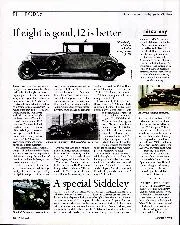WHAT WE THINK OF THE SPEED LIMIT
S0 much has already been written and said about the 30 m.p.h. speed limit in built-up areas, that it would be easy to declare that the subject has been thoroughly thrashed out. In our opinion, however, the vital point of the whole issue has scarcely received any attention at all.
In a sentence, there can be no set limit of safe speed. Conditions vary so widely that any attempt to secure uniformly safe driving by a single speed limit is bound to result in failure. Speed, in the alternative terms of above or below 30 m.p.h. is not and never will be an indication of danger or safety.
The present speed limit can only result in making drivers use their permitted 30 m.p.h. to the full, even in places where such a speed is highly dangerous. This is a natural consequence of limiting many roads along which a higher speed is perfectly safe. Moreover, the danger to pedestrians is greatly increased by the new speed limit, owing to drivers constantly being forced to glance at their speedometers to see whether the important 30 m.p.h. mark has been reached. But it must not be thought that we are not alive to the existing state of affairs, nor to the heavy casualty list exacted by our road
traffic to-day. Leaving aside the seldom-realised truth that there will always be a certain number of people killed on the road, people who are fundamentally incapable of taking care of themselves, it cannot be denied that there are plenty of accidents caused by culpable negligence and bad driving. A minimum standard of driving ability will do much to reduce accidents, and in introducing the driving tests the present Minister of Transport has performed a
national service. The tests will not stop reckless driving, however, and by reckless driving we mean not only speed, whether it be 10 or 70 m.p.h., but driving to the danger of other road-users, along Chiswick High Road or the Kingston By Pass.
In our opinion there is only one way to curb this reckless driving, and that is by the American method of motor-cycle” speed-cops”; intelligent, skilful riders of high-speed machines. It would be useless having men who cannot distinguish good driving from bad, and it goes without saying that they must be able to handle motorcycles capable of overhauling the fast American saloons, which are now selling in great numbers in this country. The result would then be a sliding scale speed limit so to speak, and the fast sports car driver, who has his machine under perfect control and has a highly developed road sense, would not be hampered by arbitrary restrictions. At the same time those nervous, hesitant and unimaginative drivers who seldom exceed 30 m.p.h., and yet are a constant source of danger, would be subjected to continual correction and reprimanding by the “speed-cops.” Under the present rule, as they do not exceed 30 m.p.h., they escape the attention
of the police-car occupants, who are only interested in whether a motorist is doing 29 m.p.h. or 31 m.p.h. Economically, the motorcyclist system has every
thing in its favour. The police-cars have a crew of two and sometimes three. Taking the cheaper cost of motor-cycles as opposed to cars, it would be fair to say that three times as many patrols could be operated as there are today.
The result would be real road safety.









